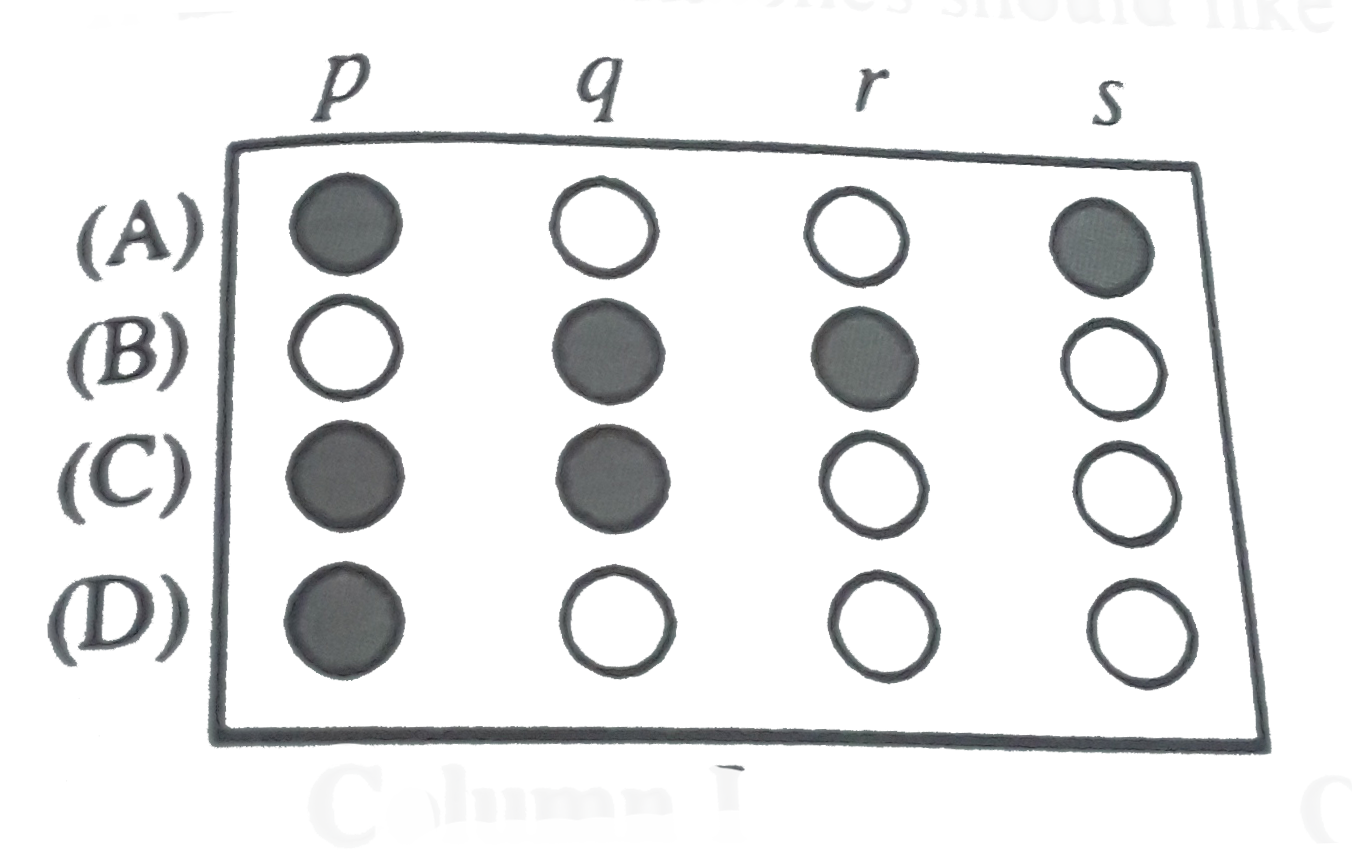Match the column
Column I (Acid)Column II (pKaValue)(A) HCOOH(p) 1.73(B) CH3COOH(q) 3.74(C) PhCOOH(r) 4.17(D) (COOH)2(s) 4.75
The correct Answer is:A-q,B-s,C-r,D-p
To solve the problem of matching the acids in Column I with their respective pKa values in Column II, we need to analyze the acidity of each acid based on their structures and the influence of substituents on their acidity.
1. Identify the Acids:
- (A) HCOOH (Formic Acid)
- (B) CH₃COOH (Acetic Acid)
- (C) PhCOOH (Benzoic Acid)
- (D) (COOH)₂ (Oxalic Acid)
2. Understand pKa Values:
- pKa is a measure of the strength of an acid; the lower the pKa value, the stronger the acid.
- We need to match each acid with its corresponding pKa value from the options provided.
3. Analyze Each Acid:
- HCOOH (Formic Acid): This is a strong acid among the given options due to the absence of electron-donating groups. It has a pKa of approximately 3.75.
- CH₃COOH (Acetic Acid): The presence of the methyl group (CH₃) is an electron-donating group, which makes it less acidic than formic acid. Its pKa is around 4.76.
- PhCOOH (Benzoic Acid): The phenyl group (Ph) is less electron-donating than the methyl group, making benzoic acid more acidic than acetic acid. Its pKa is about 4.20.
- (COOH)₂ (Oxalic Acid): Oxalic acid is a dicarboxylic acid and is generally more acidic than the monocarboxylic acids listed. Its pKa is around 1.25.
4. Match Acids with pKa Values:
- (A) HCOOH → (q) 3.74
- (B) CH₃COOH → (s) 4.75
- (C) PhCOOH → (r) 4.17
- (D) (COOH)₂ → (p) 1.73
Final Matching:
- (A) HCOOH → (q) 3.74
- (B) CH₃COOH → (s) 4.75
- (C) PhCOOH → (r) 4.17
- (D) (COOH)₂ → (p) 1.73
- (A) HCOOH (Formic Acid)
- (B) CH₃COOH (Acetic Acid)
- (C) PhCOOH (Benzoic Acid)
- (D) (COOH)₂ (Oxalic Acid)
- pKa is a measure of the strength of an acid; the lower the pKa value, the stronger the acid.
- We need to match each acid with its corresponding pKa value from the options provided.
- HCOOH (Formic Acid): This is a strong acid among the given options due to the absence of electron-donating groups. It has a pKa of approximately 3.75.
- CH₃COOH (Acetic Acid): The presence of the methyl group (CH₃) is an electron-donating group, which makes it less acidic than formic acid. Its pKa is around 4.76.
- PhCOOH (Benzoic Acid): The phenyl group (Ph) is less electron-donating than the methyl group, making benzoic acid more acidic than acetic acid. Its pKa is about 4.20.
- (COOH)₂ (Oxalic Acid): Oxalic acid is a dicarboxylic acid and is generally more acidic than the monocarboxylic acids listed. Its pKa is around 1.25.
- (A) HCOOH → (q) 3.74
- (B) CH₃COOH → (s) 4.75
- (C) PhCOOH → (r) 4.17
- (D) (COOH)₂ → (p) 1.73
- (A) HCOOH → (q) 3.74
- (B) CH₃COOH → (s) 4.75
- (C) PhCOOH → (r) 4.17
- (D) (COOH)₂ → (p) 1.73
Topper's Solved these Questions
Similar Questions
Here each questions contains statements given in two columnns which have to be matched. Statements in Column I are labelled as A, B C and D wheras the statements in Coloumn II are labelled as p,q,r and s. the answer to these questions are to be appropriately bubbled as illustrated below in the following example. if the correct matches are A-P, A-s,B-q, B-r, C p ,C-q and D-p, their correctly labelled 4 x 4 matrix should look the .

Column IColumn II(A) GeO(p) Amphoteric (B) CO(q) Boric(C) SnO2(r) Acidic(D)Te2O(s) NeutralView SolutionMatch the column
Column IColumn II(A). CH3MgBr(P). PhCH2COCl(B). PCl5(Q). PhCH2COOCH3(C). NH3, followed by heating(R) CH4(D). CH3OH in the presence of conc. H2SO4(S). PhCH2CONH2View Solution
Knowledge Check
- Question 1 - Select One
Match the compounds given in column I with oxidation states of carbon given in column II and mark the appropriate choice.
Column IColumn II(A)C6H12O6 (i) +3(B)CHCl3 (ii) -3(C)CH3CH3 (iii) +2(D)(COOH)2 (iv) 0A(A) → (iv), (B) → (iii), (C) → (ii), (D) → (i)B(A) → (i), (B) → (ii), (C) → (iii), (D) → (iv)C(A) → (ii), (B) → (iii), (C) → (iv), (D) → (i)D(A) → (iii), (B) → (ii), (C) → (i), (D) → (iv) - Question 2 - Select One
Column IColumn II (pH)(A)MilK(p)2.2(B)Human saliva(q)6.4(C)Human blood(r)6.8(D)Lemon juice(s)7.4
AA-p, B-q, C-s, D-rBA-r, B-q, C-s, D-pCA-r, B-s, C-q, D-pDA-q, B-r, C-s, D-p - Question 3 - Select One
Match the Column I with column II and mark the appropriate choice.
Column IColumn II(A)Coal gas(i)CO+H2(B)Synthesis gas(ii)CH4(C)Producer gas(iii)H2+CH4+CO(D)Natural gas(iv)CO+N2A(A) → (i), (B) → (ii), (C ) → (iii), (D) → (iv)B(A) → (iii), (B) → (i), (C ) → (iv), (D) → (ii)C(A) → (iv), (B) → (iii), (C ) → (ii), (D) → (i)D(A) → (i), (B) → (iii), (C ) → (i), (D) → (iv)
Column IColumn II(A)ΘCH3(P) Nucleophile(B) BF3(Q) Base(C) .CH3(R) Electrophile(S) Acid
View SolutionMatch the statements in Column I labeled as (a), (b), (c ), and (d) with those in Column II labeled as (p), (q), (r ), and (s). Any given statement in Column I can have correct matching with one or more statements in Column II.
Column IColumn II(a) Lithium atom(p) 54.4 eV(b) Helium atom(q) 13.6 eV(c) Beryllium atom(r) 122 eV(d) Hydrogen atom(s) 217.6 eVView SolutionMatch the names of carboxylic acids in column I with pka value in column II.
Column IColumn II(A). Benzoic acid(P). 4.17(B). Ethanoic acid(Q). 4.14(C). o-methyl benzoic acid(R). 4.74(D). p-florobenzoic acid(S). 3.91View SolutionHere each question contains statements given in two column which have to be matched. Statements in columns I are labelled as A, B, C and D where as the statements in column II are labelled p, q, r and s. The answers to these questions are to be appropriately bubbled as illustrated in the following example.
If the correct matches should like the following.

Column IColumn II(A)SO2(p)Basic(B)H2SO4(q)Acidic(C)HNO3(r)Reducing(D)NH3(s)OxidizingView SolutionMatch the following :
Column-IColumn-II(A)3s1(p)n=3(B)3p1(q)l=0(C)4s1(r)l=1(D)4d1(s)m=0(t)m=±1View Solution

